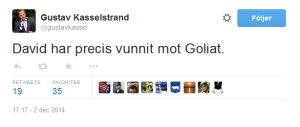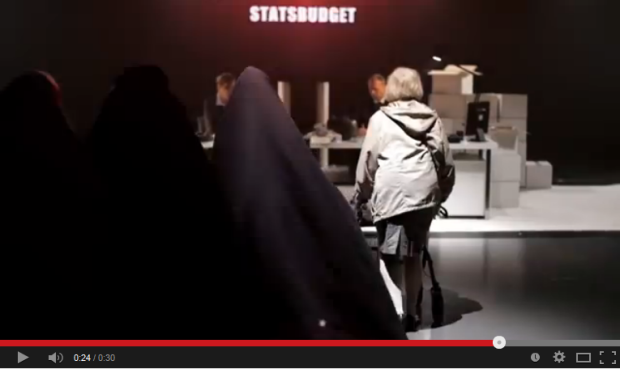Today it is impossible to write a blog post about anything other than the political crisis Sweden just plunged into. Far-right Sweden Democrats has decided to vote against the budget proposed by the Social Democratic/Green Party minority government in tomorrow’s vote, which means the opposition’s shadow budget will win and create political chaos. This is a development as unexpected as it is expected. As PM Stefan Löfven threatens to resign, the opposition blames the government and the government the opposition. It is safe to say the ‘establishment’ is stunned. How could this happen?
Ever since the Sweden Democrats (SD) became a player to be reckoned with (around 2006 when the party first reached parliament) they have portrayed themselves as ‘Davids’ against Goliath – with Goliath being the “establishment”. By ‘establishment’ I refer to politicians, journalists, cultural personalities and others active on the Swedish political scene who discountenances the Sweden Democrats. The ‘establishment’ is however SD’s own wording/framing and should only be used with that kept in mind. This “establishment” has shunned SD in every way, concurrently as support for the party has grown exponentially. This has put Sweden in a situation where neither blocs (social democratic and liberal) can reach majority, leaving SD with the casting vote. Thus, their position has gone from peripheral to central, and as we have seen today; very powerful.
 SDU’s (Sweden Democratic Youth) president Gustav Kasselstrand: “David has just won against Goliath.”
SDU’s (Sweden Democratic Youth) president Gustav Kasselstrand: “David has just won against Goliath.”
This development can be analysed using SD’s and the “establishment’s” stories and counter stories. Doing so, light can be shed on how usage of narratives can lead to political influence. Firstly, I will describe SD’s narrative of Sweden, and then how they have used this narrative to create the David/Goliath story about themselves. Secondly; due to lack of space my next blog post will be devoted to the “establishment’s” counter frame instead of cramming that into this one.
By using frames, SD has created a narrative about Sweden. There are three notable frames:
- Immigration is on a level that is irresponsibly high- it is now ‘mass’ immigration. This is hurtful for Sweden’s a) national identity c) safety b) general welfare.
- Crime needs to be battled; with tougher sentencing in particular.
- Conditions for the elderly need improving.
As different as the three may seem, together they make up a coherent story. The immigration frame conditions the story as it brings the frames together. Due to ‘mass immigration’ the welfare system is crumbling; Sweden can no longer afford to keep the truly deserving, such as the elderly, fed and warm. With immigration, Sweden is also importing crime and unrest. Thus, each frame tells its own story, which in turn fits into and reinforces the larger narrative (Afoko, Vockins 2013:8). In this case, immigration has had the prefix ‘mass’ added to it, making the second and third frames consequences of this first undisputed fact. By doing so, the narrative takes the form of a choice: either we prioritise ‘mass immigration’, or we prioritise welfare and security. We cannot have both. This choice is what makes up the plot.

“Cuts in pensions or immigration? You decide. It is Your country – Your choice!”
The characters of the story are the protagonists/heroes and antagonists/villains. The protagonists are the Swedes who were once the losers of globalisation, but today are defenders of everything Swedish and the “folkhem” (Swedish political concept, refers to a welfare state based on a midway between capitalism and socialism). The antagonists/villains are mainly the actors who make up the “establishment”. These are portrayed as having taken Sweden away from the Swedes, by letting immigration change and bankrupt the country. As journalist/researcher Daniel Poohl eloquently puts it, the approach is a sledgehammer blow: first it is swung upwards, towards Stockholm and the elite, and then it falls back to hit minorities and immigrants. All in one blow. Thus, protagonists can identify themselves with an empowering us against a them. This leads to the moral of the story: at some point, everyone have to take sides. We cannot protect everyone, but we have an obligation to protect what is “Swedish”.
This story is powerful in its simplicity. It is a story in black and white, and unfortunately success in politics is often about delivering an easily understood story. Furthermore, the narrative of a choice with only two alternatives is more efficient when it comes to easy votes than providing a more honest and holistic account of society, since complicated causality, short-term losses/long term gains and uncertainty will not win as many votes. Many voters are simply not enough interested in politics and economics to follow a line of reasoning too far, which makes politics an art of keeping balance.
To conclude, SD has created a narrative of a party made up of Davids, a strong metaphor of the righteous underdog that is the only real oppositional voice in society. Goliath is the big and powerful establishment that is patronising and elitist, but underestimating of David. Today, SD is Sweden’s third biggest party and has indeed blindsided the establishment. This is much due to their ability to tell a consistent, memorable, and simple story; one that clearly paid off, most profoundly so today.
To get a clear visualisation of SD’s story, check out this ad from the 2010 election:
https://www.youtube.com/watch?v=XkRRdth8AHc
In my next blog post I will analyse the counter frame and discuss how it could have lost so much ground.
Reference: Carys Afoko and Daniel Vockins 2013 ‘Framing the Economy’ report by the New Economics Foundation
Poohl, Daniel: “SD framme vid sitt mål – och nu sluter nazisterna upp” Published in Dagens Nyheter 18/12/14. Collected 18/12/14 http://www.dn.se/kultur-noje/kulturdebatt/sd-framme-vid-sitt-mal-och-nu-sluter-nazisterna-upp/
